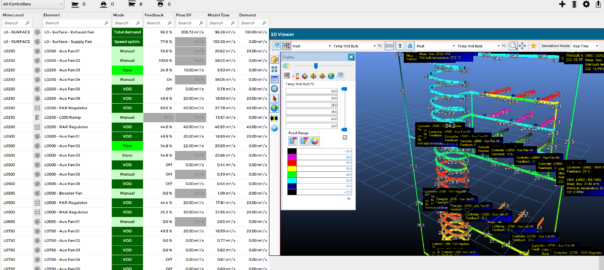Howden’s Ventsim™ CONTROL may have been introduced 15 years ago in Canada, but the cutting-edge mining innovation continues to be refined, the company says.
Ventsim is designed to reduce energy consumption, associated costs and improve energy efficiency in underground mine ventilation systems.
The Ventsim software suite uses advanced algorithms to analyse real-time data and adjust ventilation equipment to maximise energy savings while maintaining safe working conditions. As the global mining industry continues to face increased pressure to reduce its carbon footprint, it offers a valuable solution by optimising energy usage and reducing wasted energy, Howden says.
Howden, a Chart Industries Company, has focused on innovation with this software to meet the needs of ventilation and automation engineers by developing a solution that requires no prior programming. The site team can manage Ventsim CONTROL on an ongoing basis which means there is no need to continually bring in third parties to make changes as the mine’s requirements change.
This was a need in the market in 2009 when Ventsim software was introduced. The software has become even more relevant today, where resources are expensive and scarce, and mine plans – in many cases – need to be commodity price sensitive. Ventsim CONTROL can incorporate sensors, hardware, and software from any third-party supplier and has grown to become a key ventilation-engineering tool across the mining sector.
In recent years, Howden has developed the software with the complementary addition of 3D modelling and simulation components of Ventsim DESIGN, a mine ventilation simulation software, to allow mining companies to achieve optimal visualisation of their ventilation systems across their operations.
In a recent update, the software’s 3D tracking visualisation of personnel and vehicles was improved through the ability to tap into existing site-wide tracking systems at most modern underground mines.
Benoit Dussault, Lead Software Engineer at Howden, told IM: “We are working hand-in-hand with tracking providers on this solution, incorporating the x, y, z coordinates associated with these ‘tags’ or deploying a zone-based approach where these coordinates are not available.”
A real-time gas simulation that can incorporate data inputs from gas sensors around the mine and predict the gas concentrations going into areas not equipped with sensors is also being integrated into the software platform as part of expanded control and optimisation functionality. The same can be said about heat simulation, which was introduced last year.
The company is also refining its energy management and control toolkit, building on the energy dashboards it has had in place to visualise energy consumption, energy savings and, more recently, carbon emissions.
“We are implementing a carbon calculator this year that builds on those energy reports,” Dussault explained. “The software will track your emissions, allowing companies to benchmark their consumption and emissions against a plan.”
Later in 2023 and into 2024, the company hopes to put ventilation-focused, artificial intelligence-backed algorithms to work at mine sites, potentially taking the company’s ventilation optimisation abilities to new heights.
This would also coincide with a new web-based interface, introducing BI dashboards and reporting to an already impressive line-up of features.
While all these elements have global applications – and Howden itself is a global player in the ventilation sector – Dussault was keen to emphasise Canada’s influence on the ongoing evolution of Ventsim CONTROL: “Our first full Ventilation on Demand installation projects were in Canada back in 2009 and 2012. The latter, the Newmont Eleonore mine, is still significant for us from a project perspective. They [the mines in Canada] continue to play a vital role in developing the software continuously.”







